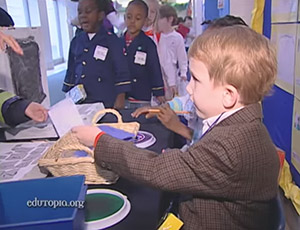![]() If you’re following any educational organization on Twitter these days, you’ve likely seen the hashtag, #PBL (Project-Based Learning). But, what’s all the buzz about?
If you’re following any educational organization on Twitter these days, you’ve likely seen the hashtag, #PBL (Project-Based Learning). But, what’s all the buzz about?
Project-Based Learning is not a new idea. In fact, it dates back to the time of Socrates. You see, humans are not wired to retain meaningless facts like a computer; we function best when ideas can be related to one another, questioned, taken apart, and put back together again. Just as Socrates taught his students (Plato) to ask questions in order to understand even the simplest idea, PBL encourages learners to explore, ask/respond to questions, and even… drumroll please… acknowledge and accept that some questions cannot be answered, or that finding a solution to one problem might cause another. Project-Based Learning is the antithesis of standardized tests and prescribed curriculum, and yet, teachers who use it habitually in their classrooms consistently see higher test scores from their students.
So, what is it? PBL is a teaching method that is backed by research and promotes authentic learning. Unlike rote memorization or dog-and-pony-show worksheets, PBL is content-saturated. Students who engage in Project-Based Learning spend longer amounts of time on a single project, but cover more diverse content with a unique focus. For example, a teacher who is interested in developing an interdisciplinary lesson plan that sharpens literacy skills, but also encourages students to engage with the history and science of a pollinator habitat, might create a lesson plan like this one from the Field Day App Team.
You might be thinking… This sure sounds like some other things I’ve read about. And you’re right! The following types of learning are similar to Project-Based Learning:
- Active Learning
- Socratic Questioning
- Place-Based Learning
- Cooperative Learning
- Inquiry-Based Learning
- Essential Questions in Lesson Plans
How is PBL different from doing a project? In the past, a student might have been asked to “do a project” on, say, the Solar System. More often than not, the student would spend hours attempting to decode the teacher’s expectations. Even when concrete directions, specific standards, and refined guidelines are provided, students often fixate on getting the right answer. PBL removes these restrictions and gives students the freedom to direct their own vision of the project from the beginning. The teacher is involved in the conception and organization of the project; however, it is the students who take responsibility for the learning process. They exercise creativity and targeted questioning to arrive at the same destination (a presentation or a blog post), regardless of the route they take to get there.
Since the early twentieth century, teaching has been equated with passively distributing knowledge by lecturing at the front of a traditional classroom. In modernity, teaching means facilitating a learning experience that cultivates students’ ability to think critically, analyze problems, and embrace different, yet equally valid solutions. Project-Based Learning is the ideal vessel for twenty-first century learning.
Why should you use Project-Based Learning? Teachers who are interested in developing cutting-edge classrooms that foster the growth of creative, conscientious citizens should use Project-Based Learning. According to PBL expert, the Buck Institute for Education, twenty-first century educators should use PBL because:
- PBL promotes active, authentic learning and combats boredom in the classroom.
- PBL increases students’ retention of knowledge and their ability to apply what they have learned in real-world situations.
- PBL encourages students to develop twenty-first century skills like problem solving, critical thinking, and personal responsibility.
- PBL aligns with the Common Core and state standards; by using it, teachers can satisfy administrators and use best practices in their classrooms.
- PBL meshes well with modern technology, so teachers and students can collaborate, create, and share projects more effectively.
- PBL gives more responsibly to the student to engage in active learning; consequently, teachers learn the joy of learning and working alongside their students instead of passively lecturing at the front of the classroom.
- PBL is a rigorous, structured, and effective way to cover interdisciplinary standards and differentiate instruction to meet the needs of all learners.
While education, as an industry, is notorious for jumping on and off bandwagons and trendy curriculum changes, Project-Based Learning is time-tested, teacher-approved, and here to stay.
Erica Stone is the Social Media Specialist for the Field Day App. She is an experienced educator and PhD Student at the University of Denver. Erica believes in process-based teaching, which includes community involvement as well as self-directed, reflective, and experiential learning. Her research interests include competency-based education, project-based learning, and eradicating educational inequity through humanities-based service learning and narrative inquiry. If you’re headed to ISTE in Atlanta June 28th – July 1st you’ll find Field Day App at booth 1826



Pingback: EdTech: What’s all the Buzz about Project...
Pingback: What is Project Based Learning (PBL)? | Field Day